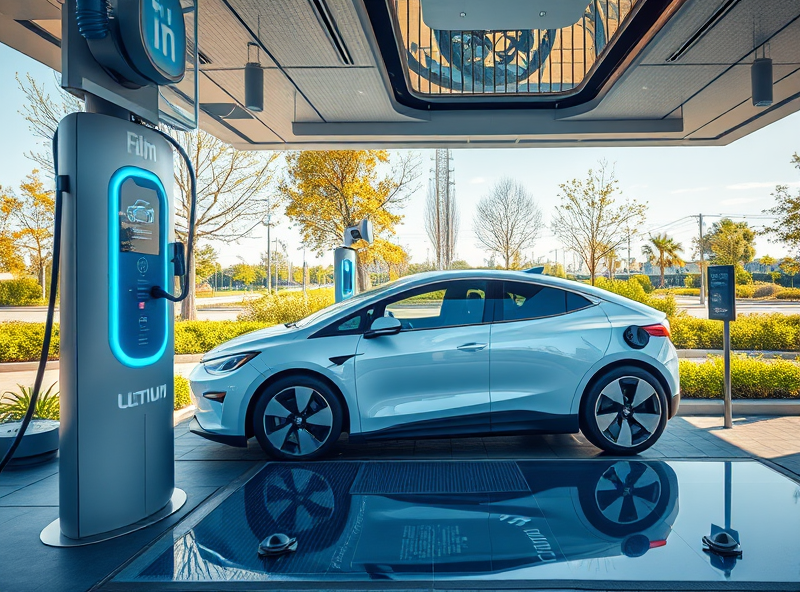
Is GM Stock a Smart Buy in 2025? EV Growth and Investment Insights
GM’s Electric Breakthrough: Ultium Platform and Rising EV Demand

General Motors (GM) is making bold strides in the electric vehicle (EV) space, and 2025 could be a pivotal year for investors watching the company’s transformation. At the heart of GM’s EV strategy is the Ultium platform—a flexible, scalable battery architecture designed to power a wide range of vehicles, from compact cars to full-size trucks. This innovation is not just a technical upgrade; it’s a strategic move that positions GM to compete with EV leaders like Tesla and BYD.
The Ultium platform offers several key advantages. First, it allows GM to reduce battery costs through vertical integration and modular design. Second, it supports fast charging and long-range capabilities, which are essential for consumer adoption. Finally, the platform’s flexibility enables GM to roll out multiple EV models across its brands—Chevrolet, GMC, Cadillac, and Buick—without redesigning the core battery system each time.
As EV demand continues to rise globally, driven by stricter emissions regulations and growing consumer interest in sustainable transportation, GM is well-positioned to capture market share. According to the International Energy Agency (IEA), global EV sales are expected to exceed 20 million units by 2025, more than double the number sold in 2022. GM’s aggressive EV roadmap, which includes launching 30 new EVs globally by 2025, aligns well with this trend.
For investors, this means GM stock could offer long-term growth potential, especially as the company transitions from a traditional automaker to a tech-forward EV leader. However, it’s important to monitor execution risks, such as supply chain challenges and competition from both legacy automakers and EV startups.
For more on global EV trends, visit the International Energy Agency’s EV Outlook: https://www.iea.org/reports/global-ev-outlook-2023
Roadblocks in Sight: Production Limits and EV Policy Shifts

As investors consider GM stock for 2025, it’s important to look beyond the hype of electric vehicle (EV) growth and understand the real-world challenges that could impact the company’s performance. While GM has made significant strides in EV innovation, including its Ultium battery platform and ambitious electrification goals, several roadblocks may slow down its momentum.
One of the most pressing issues is production capacity. Despite GM’s commitment to scale EV production, supply chain disruptions and limited access to critical raw materials like lithium and cobalt continue to hinder full-scale manufacturing. These constraints could delay the rollout of key models like the Chevrolet Silverado EV and the Cadillac Lyriq, affecting revenue projections and investor confidence.
Additionally, policy uncertainty poses another challenge. While the U.S. government has offered generous EV tax credits and incentives, these policies are subject to political shifts. For example, changes in administration or congressional control could result in reduced subsidies or stricter sourcing requirements for EV components, directly impacting GM’s eligibility for incentives and consumer demand.
Internationally, GM also faces hurdles in key markets like China and Europe, where local competitors and evolving regulations create a complex landscape. Adapting to each region’s emission standards and consumer preferences requires agility and substantial investment.
In short, while GM’s EV strategy holds promise, investors should stay informed about these potential obstacles. Monitoring production timelines, raw material supply trends, and regulatory developments will be crucial for making a smart investment decision in 2025.
For more insights on EV policy changes, you can refer to the U.S. Department of Energy’s official updates: https://www.energy.gov/eere/electricvehicles/electric-vehicles-tax-credits-and-other-incentives
GM’s Electric Breakthrough: Ultium Platform and Rising EV Demand

As we look ahead to 2025, General Motors (GM) is positioning itself as a formidable player in the electric vehicle (EV) market. At the heart of this transformation is GM’s Ultium platform—an innovative, modular battery system designed to power a wide range of EVs across its brand portfolio. This flexible architecture not only reduces production costs but also enhances performance and scalability, making it a cornerstone of GM’s long-term EV strategy.
Analysts are increasingly optimistic about GM’s stock outlook, largely due to its aggressive EV push and significant R&D investments. According to recent data from analysts at Morgan Stanley and Goldman Sachs, GM holds a ‘Buy’ rating with a 12-month price target that suggests strong upside potential. These projections are backed by GM’s commitment to invest over $35 billion in EV and autonomous vehicle development through 2025.
The Ultium platform enables GM to produce vehicles with ranges of up to 450 miles on a single charge, a critical factor in consumer adoption. Moreover, GM’s partnership with LG Energy Solution to build battery cell plants in the U.S. is expected to secure supply chains and reduce dependency on foreign sources.
For investors, GM’s focus on electrification, combined with its legacy manufacturing expertise and strong brand recognition, presents a compelling case. However, it’s important to monitor global EV competition and regulatory shifts that could impact profitability.
For more in-depth analysis, you can refer to GM’s official investor relations page: https://investor.gm.com
GM’s Electric Breakthrough: Ultium Platform and Rising EV Demand

General Motors (GM) is making bold moves in the electric vehicle (EV) space, and 2025 could be a pivotal year for investors evaluating its long-term potential. At the heart of GM’s EV strategy is the Ultium platform — a flexible, scalable battery architecture designed to power a wide range of vehicles, from compact cars to full-size trucks. This innovation allows GM to reduce production costs, improve range, and accelerate its transition to an all-electric future.
The global EV market is projected to grow significantly in the coming years, driven by stricter emissions regulations, increasing fuel prices, and consumer demand for sustainable transportation. According to the International Energy Agency (IEA), EV sales are expected to reach 35% of total vehicle sales by 2030. GM plans to launch over 30 new EV models globally by 2025, with significant investments in battery plants and software development.
However, investors should weigh the long-term promise against short-term risks. GM faces stiff competition from Tesla, Ford, and emerging EV startups. Additionally, the EV market is still vulnerable to supply chain disruptions, raw material price volatility, and evolving government policies.
Still, GM’s commitment to electrification, backed by strategic partnerships and its robust manufacturing capabilities, positions it as a strong contender in the EV race. For long-term investors with a moderate risk appetite, GM could be a smart buy — especially if it continues to execute on its EV roadmap and adapts to market shifts.
For more on EV market trends, you can visit the International Energy Agency’s EV Outlook: https://www.iea.org/reports/global-ev-outlook-2023






